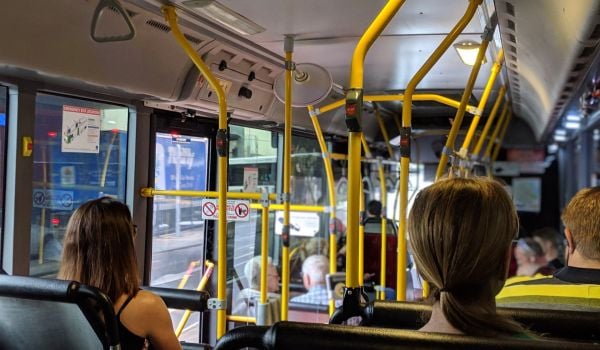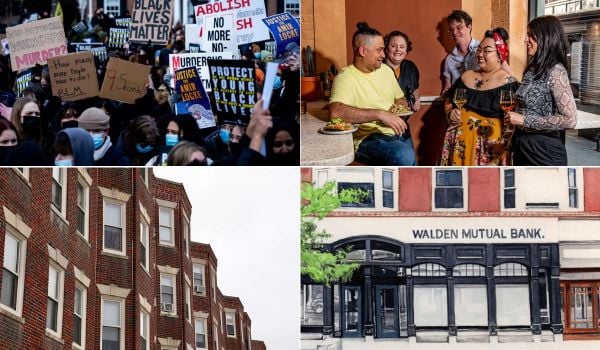Welcome to “The Mobile City,” our weekly roundup of noteworthy transportation developments.
History was made Dec. 15 when President-elect Joe Biden named former South Bend, Indiana, Mayor Pete Buttigieg as his Secretary of Transportation. In addition to being the first openly gay member of a U.S. President’s Cabinet, Buttigieg is also noteworthy both for his lack of hands-on experience managing any sort of transportation department or agency and for his small-city background. But according to one analysis of the appointment, this may actually be a good thing, for it may mean that federal transportation policies may actually pay attention to those Americans who get the lowest quality of transit service, namely, those living in our smaller cities.
But just because one lives in a big city doesn’t mean that they get great transit service either. Baltimore transit advocates have long been critical of the quality of transit service in Maryland’s largest city. Gov. Larry Hogan’s total makeover of Baltimore’s bus network, Baltimore Link, was supposed to fix that problem. The transit advocates have now taken a look at Link, and they find it just as bad as what it replaced.
And as COVID-19 has lowered the quality of transit service in cities large and small, leaders in one city have pushed back against service cuts. Boston Mayor Marty Walsh, City Council President Kim Janey and other city officials joined the Massachusetts Bay Transportation Authority’s (MBTA) own Advisory Board in calling on the agency to hold off on service cuts it planned to implement as a cost-cutting move. And as a result, those cuts are now on hold, at least for the time being.
The Pros and Cons of Biden’s Choice of Mayor Pete as Transportation Secretary
President-elect Joe Biden’s choice of Pete Buttigieg as Transportation Secretary has caught many observers by surprise, an analysis of the appointment in Streetsblog USA notes. His choice cuts against the grain in several ways: He has no prior experience in the field of transportation, for one, and such experience with the subject as he has had comes solely from his being mayor of a Midwestern city of just barely more than 100,000 residents.
But, Kea Wilson writes, many others see these things as possible strengths. Cities like South Bend, they say, have some of the poorest transit service in the country, and having someone who knows them at the top of the transportation policy heap might mean they finally get some attention. Bruce Katz of the Brookings Metropolitan Policy Program said in a Tweet, for instance, that his appointment would mean “leaders from slow growing, older industrial metros would set transportation and housing policy — that perspective has been sorely missing from federal decision-making for a long long time.”
On top of that, Buttigieg’s plan for transportation during his presidential campaign was one of the most ambitious put forth by any Democratic candidate. He proposed a $150 billion budget for the Federal Transit Administration, 13 times what it now spends. He was also the only Democratic presidential candidate who proposed switching from a volumetric gas tax to a vehicle-miles-traveled tax as the basis for funding our ground transportation system. Such a switch would better capture the amount of use our roads get in an era when more and more vehicles use less and less fossil fuel, and it could also reduce the amount of driving if the taxes are properly implemented.
And he also was the only candidate who pledged to confront the continuing carnage on our nation’s streets and roads, where more than 40,000 people are killed in motor vehicle incidents each year. Vision Zero Network Director Lee Shaum praised his emphasis on safety, adding, “Given his experience, he is likely to understand that local communities need more voice in transportation decisions, which has not been well-understood enough at the Federal level. We expect that Buttigieg understands how the intertwined crises of climate change, economic pain and systemic racism facing our nation can be improved upon with smart transportation choices and real leadership that isn’t afraid to challenge the status quo.”
And even though he was criticized for racial insensitivity, as mayor, he did implement several reforms that sought to create a more balanced transportation network in South Bend.
One anonymous industry insider told Streetsblog, “You don’t want an implementer in the secretary spot, you want someone who can liaison to Congress,” and added that Buttigieg’s deputy and top staff would become important in playing that role. But overall, Wilson argues, his recognition that our national transportation policy has been tilted too heavily in favor of automobile transport could make him a trailblazer for the Transportation Department and a positive reinforcement for “Amtrak Joe.”
Baltimore Transit Advocates Give City’s Transit System a D Grade — Again
Baltimoreans have long complained about the quality of transit service in Charm City, the product of uncoordinated planning and a chaotic bus route structure. Those complaints grew louder when Gov. Larry Hogan took office on a platform of shifting Maryland’s transportation spending priorities from rails to roads. His cancellation of Baltimore’s proposed Red Line light rail line sent Baltimore’s civic leaders into apoplexy, especially after he declined to also pull the plug on the Purple Line in Maryland’s Washington suburbs.
Hogan’s salve for Baltimore’s wounds was Baltimore Link, a total reorganization of Baltimore’s bus network into a system of rapid bus routes through the city center and feeder and circulator routes in its neighborhoods. When he proposed it, Baltimore’s transit union said that it too could be improved on and released a BRT plan of its own.
Was the union right? According to the latest biennial report card issued by the Central Maryland Transportation Alliance (CMTA), it was.
The Baltimore Sun reports that the advocacy group gave Baltimore’s transit system a grade of D for the third straight time. The alliance’s 2020 report card was the first to be issued after Baltimore Link was implemented.
The Maryland Transit Administration’s (MTA Maryland) Baltimore-area network received F grades in five of the report’s 12 categories: job access by transit, affordability, disconnected communities, air pollution and commute time.
Baltimore Link actually reduced the percentage of area jobs reachable within an hour on public transit, to a mere nine percent. MTA Maryland riders spent 56 minutes commuting to and from their jobs, a stat made only a little less painful by the fact that nearly a quarter of all Baltimore-area workers, including drivers spent 45 minutes or more commuting to work. And Baltimore also experienced 12 days of unhealthy levels of ground ozone in 2019; by contrast, the Columbus, Kansas City and Pittsburgh metropolitan areas all had either one or no such days.
And nowhere in the report, which compares Baltimore’s transit system to those in 19 other similarly-sized metropolitan areas, did the MTA Maryland system receive a grade higher than C. The report looked at service before COVID-19 produced a significant drop in both ridership and service levels.
CMTA President Brian O’Malley told the Sun, “It’s time to start asking some hard questions about what isn’t working. Why aren’t we getting any better?”
One hindrance to making Baltimore transit better may come from how MTA Maryland is run: It’s the only one of the nation’s 50 largest transit agencies that is run directly by the state, with no board of directors, local funding or local oversight. Gov. Hogan has full responsibility for Baltimore’s transit service, and Baitmore officials have none. The nonpartisan Eno Center for Transportation also issued a report critical of this governance structure, saying, “Unfortunately, under this governance structure, metropolitan Baltimore’s public transportation system has not kept pace with repair and service needs nor has seen a new rapid transit line in more than two decades.”
State Transportation Secretary Greg Slater said he would review both reports in the coming weeks and that his office would continue to “collaborate to make our entire transportation network the best it can be.”
Looks like Slater has his work cut out for him on that score.
MBTA Backs Off Implementing Service Cuts, At Least For Now
Boston Mayor Marty Walsh and City Council President Kim Janey this week joined the MBTA Advisory Board in criticizing the agency’s plan to sharply reduce transit service in Greater Boston as part of an effort to close a $600 million budget deficit for the coming fiscal year. As a result, WBTS (NBC10 Boston) reports that MBTA General Manager Steve Pollak has recommended the agency’s board put off any consideration of service cuts until February, when the T begins its budgeting process in earnest.
In remarks Monday, Walsh urged the MBTA to “be creative” in finding ways to close the budget hole. The cuts, he argued, would make it harder for low-income workers, veterans and people with disabilities to get around. In addition, the rollout of coronavirus vaccines could mean that ridership could begin rising again after the fiscal 2022 budget takes effect, thus making the cuts shortsighted as well.
Governor Charlie Baker took the opposite tack, saying that “raising taxes to run empty buses and trains is a bad idea,” but it appears that public opinion is also on Walsh’s side.
In her remarks, Janey noted that the proposed cuts continued a pattern of fare hikes followed by “temporary” service cuts that never get restored. “The so-called temporary cuts have had significant long-term impacts in the past, and begs the question, ‘When will services be brought back?’ The answer: probably never,” Janey said. “The COVID-19 crisis cannot and must not be used to as a front to continue the dismantling of services our community so desperately need. We are here this morning to say no to any cuts in service.”
The T’s Advisory Board went on record as opposed to the cuts last week (“The Mobile City,” Dec. 9). The board’s executive director, Brian Kane, told NBC10 Boston that his group argued that the agency was overestimating the size of the projected deficit and that it could achieve the needed savings without making drastic cuts in service. Moreover, the proposed cuts would actually leave the agency with a $72 million surplus at the end of the two-year budget cycle. “My folks just don’t feel like the T should be generating a surplus by eliminating public transportation,” Kane said. “It’s just not right.”
By the way, Boston isn’t the only city where transit advocates have pushed back against sharp cuts in service. In September, The Baltimore Sun reported that Gov. Larry Hogan canceled plans to severely cut back bus service in Baltimore this coming year after bus riders, business leaders, local politicians and transit advocates sharply criticized the plan. Instead, Hogan said that the Maryland Department of Transportation would cut back service on suburban commuter buses and trains, where ridership had fallen even more than it had on city bus routes.
Know of a development that should be featured in this report? Send a Tweet with links to @MarketStEl using the hashtag #mobilecity.

Next City contributor Sandy Smith is the home and real estate editor at Philadelphia magazine. Over the years, his work has appeared in Hidden City Philadelphia, the Philadelphia Inquirer and other local and regional publications. His interest in cities stretches back to his youth in Kansas City, and his career in journalism and media relations extends back that far as well.
Follow Sandy .(JavaScript must be enabled to view this email address)
















